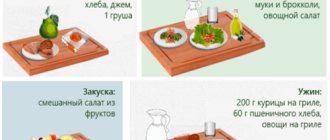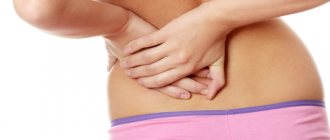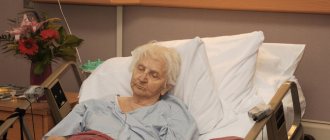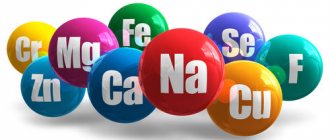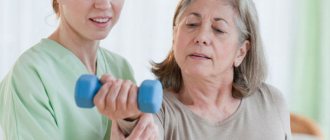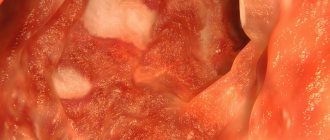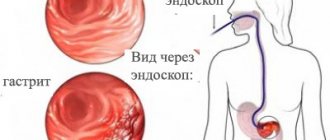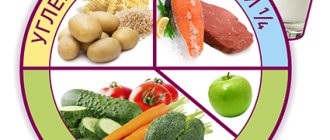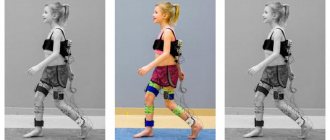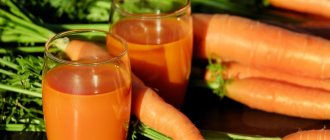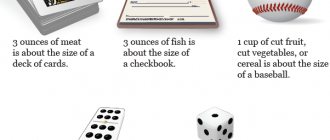A stroke is an acute disturbance of blood circulation in the brain and, as a consequence, its focal damage. It entails irreversible consequences for the body; it can disrupt clarity of consciousness, the functioning of internal organs, cause paralysis, and more. To restore the body, as well as for effective rehabilitation, the patient needs to change the usual approach to household things, observe a special regime, and follow certain nutritional rules after a stroke. Often this all becomes the responsibility of family and friends.
Diabetics after stroke
Stroke and diabetes are closely related.
Diabetic patients are 2.5 times more likely to have a cerebral hemorrhage than healthy people. Moreover, in 90% of cases in diabetics it is an ischemic stroke. In such patients, disturbances in the water-salt balance lead to coarsening of the vessel walls, their narrowing; after a stroke, the recovery process is slowed down, since vascular atherosclerosis slows down the supply of oxygen needed by the brain.
Diet is a forced but necessary measure for recovery. Extremely important:
- completely eliminate salt;
- take potassium to strengthen the walls of blood vessels;
- drink plenty of liquids (water, compotes, weak tea);
- avoid foods with high cholesterol levels;
- eat plenty of fruits and vegetables.
Direct cause-and-effect relationship – stroke develops against the background of diabetes, and not vice versa.
Conclusion: Diet plays a huge role in maintaining a healthy state.
An example of a one-day home menu for a patient
In the morning, breakfast after hygiene procedures:
- liquid low-fat cottage cheese diluted with milk;
- toast brushed with honey;
- green tea with mint.
After 1.5–2 hours - banana.
For lunch:
- vegetable broth soup seasoned with buckwheat;
- steam cutlet with grated carrot and cabbage salad;
- freshly squeezed fruit juice or grated apple.
For afternoon snack: chicory drink with dry cookies.
For dinner:
- steamed fish with mashed potatoes;
- prune compote.
Shortly before bed: a glass of yogurt or kefir.
Since many people get confused when it comes to preparing boiled dishes, we provide dietary recipes.
Porridge with pumpkin
You can cook it from rice or millet cereals to taste, or mix them in half.
Peel the pumpkin, cut into cubes, add water (2-3 cups) and cook for 10 minutes.
Add washed millet or rice (to remove gluten, it is better to first soak them in water for 2 hours) and cook for another 15 minutes, stirring.
Once ready, wrap the pan tightly with a warm cloth and leave the porridge to simmer.
Add a teaspoon of butter to a plate. You can replace it with honey.
The essence of diet after a stroke
Diet Table 10 according to Pevzner after a stroke is aimed at optimizing the restoration of health and preventing relapse. It is both a therapeutic and preventive measure, which is based on proper nutrition.
Diet Table 10 according to Pevzner - basic rules:
An innovative drug for losing weight by 30-40 kg! Removes even age-related fat without chemicals, liposuction, diets or physical exercise. Exercises
- Diet for hemorrhoids with blood: menu for every day, recipes
- Food should be varied. The diet should be rich in vitamins, minerals, fiber and all the necessary nutrients for normal life.
- Meals should be fractional. You should eat at least 4 times a day, but in small portions.
- The last meal of the Table 10 diet after a stroke should be light and at least 3 hours before bedtime.
- In the Table 10 diet, restrictions are imposed on fats of animal origin (reduced by at least half), salt (no more than 5 grams per day), sugar (no more than 50 grams per day).
- The amount of food consumed per day should not exceed 2 kilograms according to the Table 10 diet according to Pevzner after a stroke.
- You should drink about 1 liter of still water every day.
Permitted and prohibited products
Diet after a stroke - allowed foods:
- Veal, rabbit, chicken, turkey (boiled or baked on the Table 10 diet);
- Vegetarian soups;
- Low-fat varieties of fish (boiled or baked);
- Low-fat dairy and fermented milk products (butter no more than 20 grams per day);
- Eggs (no more than 1 egg per day, unlimited amounts of protein);
- Cereals and cereals (unpolished rice, buckwheat, oats, millet);
- Bread made from wholemeal flour (rye, whole grain);
- Crackers, savory cookies;
- Pasta (in limited quantities);
- Potatoes (boiled, baked, occasionally stewed);
- Cabbage, carrots, beets, eggplants, zucchini, cucumbers, tomatoes;
- Onions, garlic, horseradish, herbs;
- Apricots, bananas, dried apricots, citrus fruits;
- Berries and dried fruits;
- Jelly, puddings, marmalade;
- Unsweetened compotes, fruit drinks, jelly;
- Weak tea, decoctions of herbs and berries.
Diet after a stroke - prohibited foods:
- Pork, smoked and fried meat;
- Poultry skin;
- All types of sausages, especially salami on the Table 10 diet;
- Fatty fish;
- Smoked and fried fish;
- Fatty dairy and fermented milk products (cream, sour cream, condensed milk);
- Rich and fresh baked goods;
- Semolina;
- Legumes (beans, peas, lentils);
- Fried potatoes and chips;
- Rutabagas, turnips, radishes;
- Sorrel and spinach;
- Mushrooms;
- Grape;
- Desserts and sweets (ice cream, chocolate, candies);
- Rich broths;
- Carbonated drinks;
- Sweet fruit drinks, juices and nectars;
- Freshly squeezed vegetable and fruit juices;
- Strong coffee and tea.
Basic requirements for organizing a patient’s nutrition
The patient's nutrition in the hospital depends on the severity of his condition. If the patient is in a coma, then the necessary components are administered intravenously using special solutions. Another option is a custom table. Liquid products (milk, eggs, pureed soup) are prescribed, which are injected into Zhanna's stomach with a syringe through a nasal catheter.
When the patient regains consciousness, his ability to eat on his own, hold a spoon, and swallow food becomes more clear. If the motor function of the right or left hand is lost, they begin to gradually teach him to control the other, help him master previously familiar movements, and literally feed him from a spoon and a drinking cup.
You should continue to master the skills at home. Do not rush, scold the patient or despair. This greatly affects the desire to recover.
Take care of convenient, unbreakable dishes for eating and drinking, napkins, a towel, and a tray
Meals should be divided into 4-5 feedings. Portions for nutrition after a stroke should be kept small. All dishes should be heated, but not served very hot or cold.
Authorized Products
The patient's nutritional diet is limited as follows:
- Vegetarian dishes. Basically, these are soups prepared with potatoes, cabbage, carrots and other vegetables. You are allowed to add cereal to the soup. The soup can be milk or fruit; cold beetroot soup is recommended for consumption. The soup is seasoned with non-acidic sour cream and herbs. If your doctor allows it, you can cook soup with meat broth, but only several months after the stroke.
- Boiled poultry meat. It should be lean, low-calorie chicken or turkey. Fillet boiled in unsalted water is best. Meat contains a large amount of proteins and is very healthy.
- Lean meats. You can eat beef, veal and rabbit. Before cooking, cut off fat and tendons, anything that increases cholesterol levels and calories. The meat must be boiled.
- Low-fat fermented milk products. The fat content of milk and cottage cheese should not exceed 10%. Cottage cheese is mixed with cereals, carrots and fruits. Cheese can be eaten only in limited quantities and only low-fat varieties;
- Chicken eggs. The eggs are boiled soft-boiled, the omelet is steamed. You can only eat 1 egg per day.
In addition, patients are allowed the following products:
- Diet 10 and Table 10 and nutrition for myocardial infarction
- pasta;
- cereal;
- biscuits and soft biscuits;
- all types of vegetables;
- vegetable caviar;
- jellied fish;
- dried fruits, as well as fresh fruits and berries;
- compote, jelly, jam;
- green tea;
- still water;
- cocoa;
- honey.
All dishes should be consumed in limited quantities in accordance with the individual regimen developed by the doctor. Food must be prepared independently; it is not advisable for the patient to eat semi-finished products, again due to the calorie content and high cholesterol content.
Selected tips
We offer small culinary tricks to prevent negative emotions in the patient.
- To make food with limited salt tasty, you can add crushed garlic, parsley, dill, and seaweed.
- If the patient cannot swallow solid food, it is necessary to prepare everything in the form of purees or purchase high-quality baby food in jars at the store.
- A blender will help grind the vegetables into a mass. But you should make sure that the resulting dish is warm.
- For constipation, the menu should include a decoction of figs, dried apricots, and prunes, and drink it on an empty stomach. Be sure to give kefir in the evening.
- Legumes are very healthy; they contain folic acid, which activates the B group of vitamins. If the patient has difficulties with daily bowel movements, they should not be cooked.
Nutritionists do not advise deciding on your own the issue of adding immunostimulants (ginseng, aloe) to a patient’s drinks. They are contraindicated for hypertension. You should consult your doctor.
Prepared on the basis of flaxseed oil with cumin extract, it has valuable qualities
Vitamins and microelements necessary for successful rehabilitation
The main goal of the diet proposed by doctors is to replenish and subsequently maintain the deficiency of vitamins and microelements, which are extremely important for the full functioning of the body. Therefore, the diet should consist of foods that help reduce blood viscosity and reduce the risk of blood clots. They should saturate the brain with vital compounds.
| Vitamins, microelements and other vital compounds | Impact on the body | What products contain | Note |
| Vitamins B, C and D | Reduce the quantitative level of homocysteine, which can provoke a recurrence of stroke | Various nuts (cashews, hazelnuts), sunflower seeds, asparagus | Contains fiber useful for intestinal motility |
| Polyunsaturated acids omega-3 and omega-6 | Normalize the activity of the vascular system, improve biochemical reactions in the brain | Varieties of sea fish and seafood, olive and vegetable oils | It is not recommended to include river and lake fish in the diet |
| Folic acid | Reduces the likelihood of a recurrence of an attack in the future, normalizes blood pressure | All legumes (lentils, chickpeas, peas, beans) | Especially recommended in case of ischemic stroke |
| Calcium, phosphorus, potassium, iron, etc. | Accelerate metabolism, have a positive effect on the condition of all organ systems | All citrus fruits, tomatoes, potatoes, eggplants, bananas | After the attack has stopped, it is recommended to consume a clove of garlic once a week. |
| Protein | Helps restore the entire body | Any dietary meat (rabbit, turkey) | Fatty meats (pork, lamb) are strictly prohibited |
| Anthocyanides | Reduce capillary permeability, stabilize the functioning of the heart muscle | Various blue vegetables and fruits (eggplants, grapes, onions) | If you have problems with stool, it is better to choose seedless fruits |
| Beta carotene | Effectively reduces blood pressure levels | Pumpkin, red pepper, carrots, apricots | The body receives more benefits from raw foods. |
| Antioxidants | Remove free radicals from the body, normalize metabolic processes in the body | Blueberries, cranberries, all varieties of cabbage | To eliminate the pronounced bitterness in cranberries, they can be eaten with honey. |
| Complex carbohydrates | Effectively reduce blood cholesterol levels and activate metabolic processes in the brain | Honey, various cereals (oatmeal, barley), brown rice, apples | Products in this category are highly nutritious, which must be taken into account when preparing a diet and calculating its calorie content. |
The products presented in the table differ in availability. When it comes to vegetables and fruits, it is better to choose seasonal options. In this case, the benefits for a weakened body will be much greater.
Chances and timing
The duration of the rehabilitation period and its success are determined by several factors: the degree of brain damage, the age of the patient, etc. Gradually, new neurons appear in place of dead neurons, and some of the functions performed by the damaged parts are transferred to healthy areas. In a mild form of stroke, when there is deterioration in vision/coordination and paralysis of the facial nerves, partial recovery will take 1-2 months, and complete recovery will take 3 months. If the consequences of an attack manifest themselves in the form of impaired motor function and severe paralysis, rehabilitation will take at least six months. However, the likelihood of completely returning lost functions is minimal.
